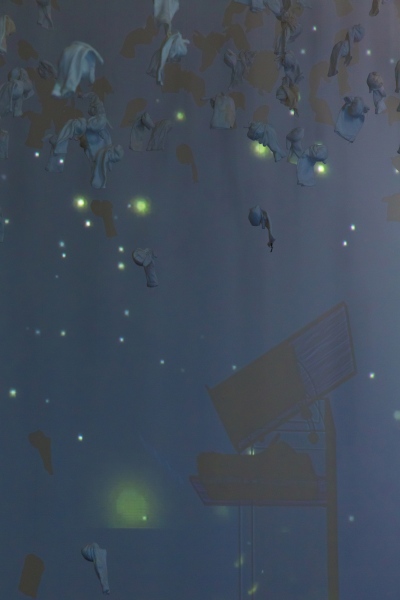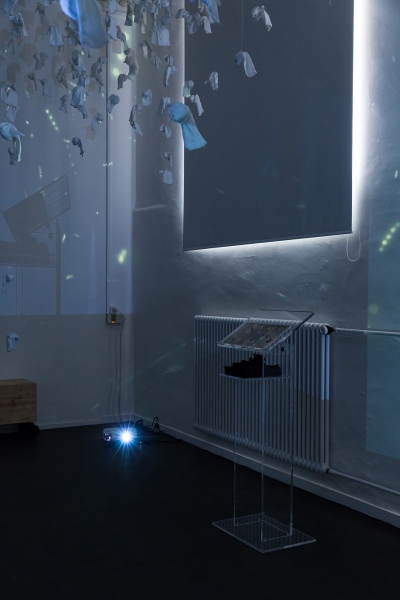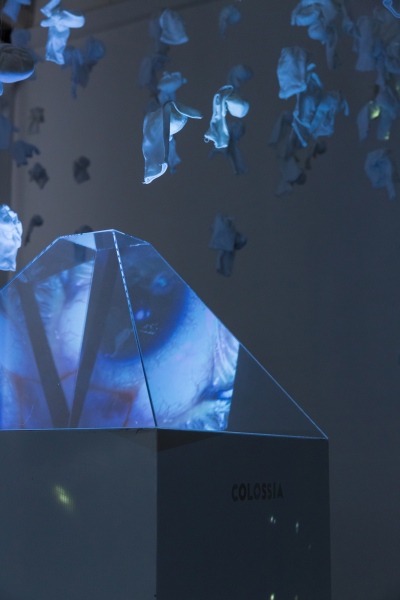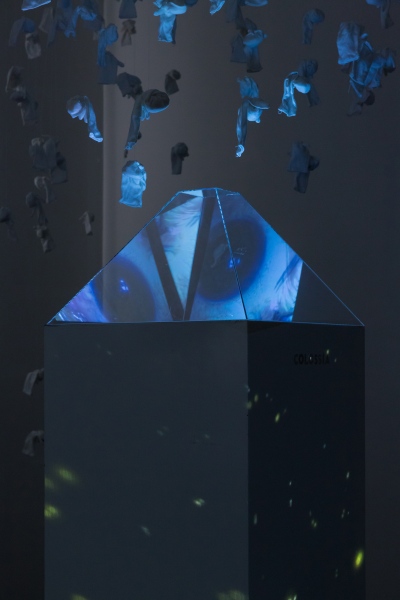
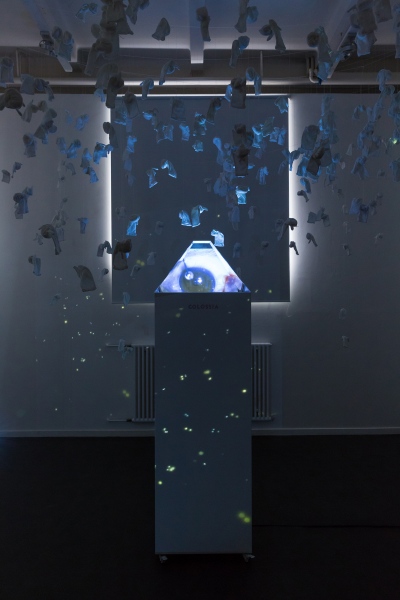
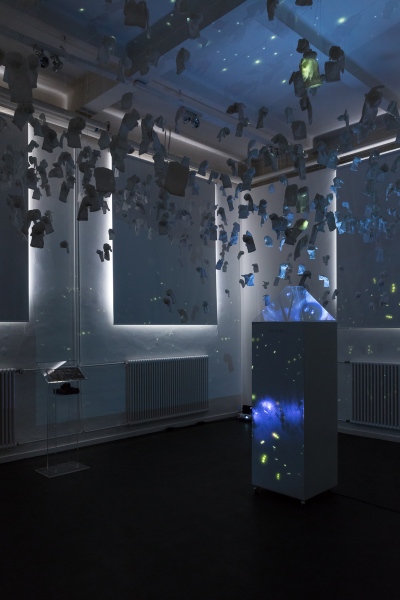
Inner Pangea
LiveInYourHead, NEW HEADS 2017, l'Oranger, 2017
Photos : © HEAD – Genève, Michel Giesbrecht
EN:
Inner Pangea and Cosmose are complementary installations, multi-layered and entangled, complex and intertwined. They are correlated by a number of recurring elements that function as refrains, combining and giving rhythm to the cosmic, terrestrial, social and affective environments the artist conceives.
Both installations feature a cloud of white gloves suspended in mid-air, a flicker of digital blue-greenish fireflies glowing in the dark, and the expectancy of Teru Teru Bozu—the invisible key to the denouement of the plot. And then, respectively, an eye within a prism and a DNA test on one side; Angela Carter’s fairy tales and the aurora borealis on the other.
Inner Pangea and Cosmose are eminently symbolic.
The “Pangea” in the title refers to the original supercontinent coexisting within the Panthalassa hundreds of millions of years ago. It reconnects us to the deep time of a primordial geological era, before the drift of continents and the origin of oceans, beyond the human scale of temporal perception. A geological conglomeration we still carry within us, in our inner-selves, like the cells of the mother who generated us and informed the substance of an ancestral planetary sorority.
Within the imaginary space of this interiorised atavistic supercontinent, humanity dwells, represented by the blue-green light of a special type of fireflies, which Galaxia encountered in Australia and reproduced by digital means. They stand for beauty and fragility—enough to say that these insects are so delicate that a single phone flash could kill them. Within the allegorical realm envisioned by the artist, they are called to evoke human beauty and vulnerability, while alluding to a threat on the prowl.
This latter is represented by the cloud of white gloves imperceptibly swinging over the viewers. Like a sword of Damocles, they are ready to fall. By their chirality, the gloves connote the dualistic and reductionist vision of those in power over social structures, accustomed to corruption, control, manipulation. By their aseptic and anonymous whiteness, they seem to suggest the hypocrite intention to keep the hands clean, to commit the perfect crime leaving no identifiable traces. But gloves are artefacts for hands and hands are human.
The human element is reintroduced in this symbolic scenario in the form of an eye, witnessing through a prism the precarious condition of humanity and the looming threat. The enlarged prism-shaped peephole through which the eye observes, recalls, by means of free association (prism = light refraction = spectral colours), a synaesthetic visual condition. The clue is self-evident: it is the eye of the artist, and notably his left eye, which has endured serious surgery and is in pain. Galaxia, in this context, acts both as a witness, and as a companion, sharing human sufferance. He offers his vision and a potential remedy: against the cloud of gloves, hanging like a menacing rain, Galaxia invokes the spirit of Teru Teru Bozu (Shine Shine Monk), a Japanese traditional handmade doll having the effect to bring good weather and prevent from raining.
The presence of the artist is redoubled by his DNA sequence, laying on a Plexiglas structure: an intimate biological representation, undressed of socio-culturally constructed identitarian traits—which often operate as a divider more than a connector.
FR:
Inner Pangea et Cosmose sont des installations complémentaires, à strates et imbriquées, complexes et intriquées. Elles sont corrélées par un nombre d’éléments récurrents qui fonctionnent comme des refrains, combinant et rythmant un environnement à la fois cosmique, social et affectif.
Les deux installations présentent des gants blancs suspendus en l’air, des lucioles numériques vacillant qui brillent dans la nuit, l’espoir qu’un Teru Teru Bozu invisible vienne dénouer le scénario. Et, respectivement, un œil dans un prisme et un test ADN dans la première ; les contes d’Angela Carter et des aurores boréales dans la deuxième.
Inner Pangea et Cosmose sont éminemment symboliques.
La Pangée dans le titre se réfère au supercontinent originaire baigné des eaux de Panthalassa, il y des millions d’années. Elle nous relie à la profondeur des temps primordiaux d’une ère géologique précédant la dérive des continents et la formation des océans, au-delà de l’échelle temporelle perçue par les humains. Un conglomérat géologique que nous portons encore, un intérieur propre, telles les cellules de la mère qui nous a engendrés et renseignent sur la substance d’une généalogie ancestrale et planétaire.
Au cœur de l’espace imaginaire de ce supercontinent atavique et intériorisé, réside l’humanité, représentée par les lumières bleues-vertes d’une espèce de lucioles que Galaxia a rencontrée en Australie et reproduit numériquement. Elles signifient la beauté et la fragilité : ces insectes sont si délicats qu’il ne survivent pas à la lumière d’un seul téléphone. Parmi le règne allégorique envisagé par l’artiste, elles sont amenées à évoquer la beauté et la vulnérabilité humaine, faisant allusion à un danger les menaçant.
Ce dernier est représenté par le nuage de gants blancs se balançant au-dessus du spectateur. Telle une épée de Damoclès, ils sont prêts à tomber. Par leur chiralité, les gants connotent la vision dualiste et réductionniste des détenteurs du pouvoir sur les structures sociales, accoutumés à la corruption, au contrôle et à la manipulation. Par leur blancheur aseptisée et anonyme, ils semblent suggérer l’intention hypocrite de garder les mains propres, afin de commettre le crime parfait sans laisser de traces. Mais ces gants sont des artefacts pour les mains et les mains sont humaines.
L’élément humain est réintroduit dans ce scénario symbolique par un œil, témoin au travers d’un prisme de la condition précaire de l’humanité et du danger qui s’annonce. Le prisme, comme un Judas agrandi par lequel l’œil observe, rappelle, par libre association (prisme=lumière réfractée=spectre de couleurs), une condition visuelle synesthésique. L’indice est clair : c’est l’œil de l’artiste, et plus spécifiquement son œil gauche, qui a subi une opération importante. Galaxia, dans ce contexte, joue le double rôle de témoin oculaire et compagnon, partageant la souffrance humaine. Il offre sa vision et un remède potentiel : contre le nuage de gants, suspendu comme une pluie menaçante, Galaxia invoque l’esprit de Teru Teru Bozu, une poupée traditionnelle japonaise qui a la faculté d’apporter un temps clément et empêcher la pluie de tomber.
La présence de l’artiste est redoublée par sa séquence ADN exposée sur une structure de plexiglas : une représentation biologique et intime, libérée des traits identitaires socio-culturels, qui souvent opèrent comme un séparateur plutôt qu’un liant.
Text written by:
Lucas Cantori, Camilla Paolino
lasurite@icloud.com
